|
|
 |
|
KATARXIS N°2
|
 |
|
New Urbanism and Style
|
 |
|
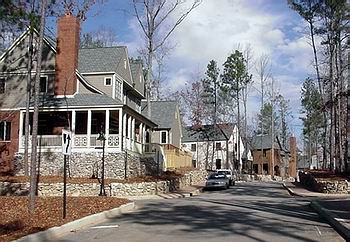
Mount Laurel
by Duany & Plater-Zyberk
(Photo by Gary Justiss)
Revivalism and Modernism
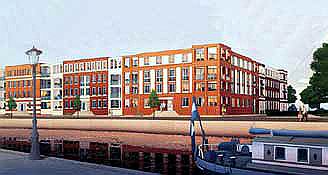
Gildenkwartier, Amersfoort, Holland
200 New Apartments near the Centre of Amersfoort
by Rob Krier and Christoph Kohl
"Being a historically modern construct, style is a by-product
of an understanding of the world that dissects time into distinct and subsequently perceived, unique periods - it is a technological
(manmade) way of compartmentalizating history. The artificial parenthesis placed around certain periods in certain places
by some historians are responsible for what we have been trained to know as styles - wether it be Greek style, Mission style,
Tudor style, Mediterranean style, Charleston style...., the list is endless and grows ever more specific. When history is
understood this way, two approaches to architectural practice ultimately result - revivalism and modernism.
It is these two attitudes that dominate current architectural
practice. Stylistical revivalists, which is what many (not all) traditional architects are, copy these particular periods
or rather the motifs from these periods with little understanding or consideration of their constructional (tectonic) or symbolic
origin. Modernists reject these stylistic periods as being nothing but of passing historical interest, irrelevant to "today".
In place of copying historic or regional styles they choose to "invent" personal styles."
Michael Mesko
(Letter posted on Tradarch List, University of
Miami)
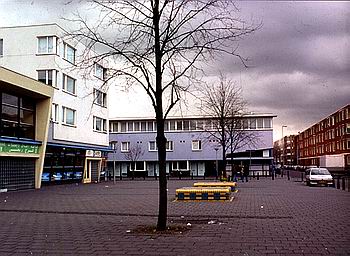
Contemporary Piazza in Den Haag, Holland
(Photo by Lucien Steil)
New Urbanism and Style
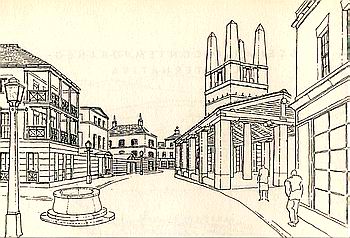
Traditional Town Building
by Léon Krier
"Choice or Fate"
(Andreas Papadakis Publisher)
"The New Urbanist debate breaks down into
two opposing camps. On one side are the stylistic revivalists - those who encourage codifying style into their urban plans
and on the other side are the modernists who suggest style is irrelevant and that any New Urbanist plan should allow for a
healthy dose of modernist architecture in their communities - at the very minimum some "Frank Lloyd Wright Style" or some
other "modernist lite style" sprinkled here and there.
The Revivalists, believing it to be the only way of guaranteeing good architecture, paralyze the practice
of architectural design by limiting its expression to one or more collections of historical motifs (the Greek Revival model,
the Victorian model, etc...). In this scenario the authority and the responsibility of the builder or architect is totally
undermined. His / Her concern becomes less, -'How do I apply tradition to the circumstances of this client and context and
thus make good urban space and enduring and appropriate architecture?'-, than -'Do I have enough acroteria and anthemion and
baseless Doric to qualify as Greek?'-, or whatever motifs are necessary to achieve the prescribed style.
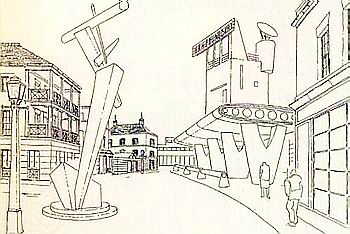
Modernist Townbuilding
by Leon Krier
"Choice and Fate"
(Andreas Papadakis Publisher)
The New Urbanists who carry the banner
for modernist styles forget that the foremost underlying premise of the modernist approach assumes each building to be a idiosyncratic
expression of the architect and his/her private ideas. Thus the idea that a building should be appropriate relative to its
rank among other buildings is impossible since each modernist building is a self contained and closed system or language.
Modernist architecture, incapable of making cities of discernable hierarchal legibility, is then quite contrary to the hierarchy
New Urbanist plans go to great lengths to establish. New Urbanists have laudably distinguished in their plans some streets,
spaces, sites, and buildings as more important than others. Modernist architecture in a traditional plan is oxymoronic."
Michael Mesko
(Letter posted on Tradarch List, University of Miami)
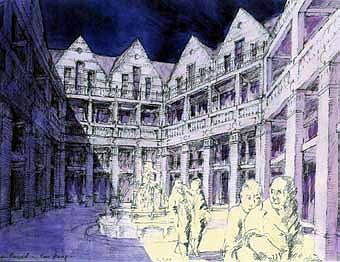
Rivierenburt, Courtyard Housing, Den Haag
by Rob Krier and Christopher Kohl
|
 |
|
|
Architecture, Style and Type
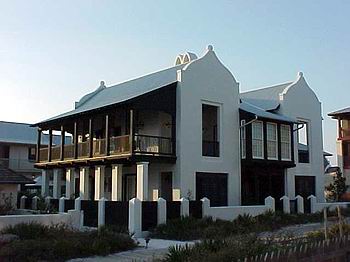
Malugen House, Rosemary Beach, Florida
by Eric Watson
(Photo by Eric Watson)
"If style, modernist or revivalist, leads
to undesirable ends, then the usefulness of this attitude towards history should be questioned. One of the ways to rid style
from current discourse is to simply remove the manmade parenthesis that currently surround historical periods, opening the
way for a cross comparison of all traditional (and even some modernist) architecture.
When something very general through time
reoccurs with undeniable frequency it can be identified as a type of "something" with many particular examples.
As architecture and city-building have always been concerned with four very general things: the way we build
buildings, the content of buildings, how buildings relate to other buildings and spaces, and how buildings alter existing
contexts - these general concerns can be identified as types.
Recognized as structural types, building types, urban types and types of modification, each can serve as
a heading under which every particular example (regardless of time or context) can be classified. Understood this way the
practice of architecture involves itself with the adaptation of appropriate particular examples (models) to contemporary circumstances
and contexts.
Style becomes a non-issue, tradition is preserved, enlargened upon, and begun in places where it does not
exist (suburbia for example)!
Michael Mesko
(Letter posted on Tradarch List, University of Miami)
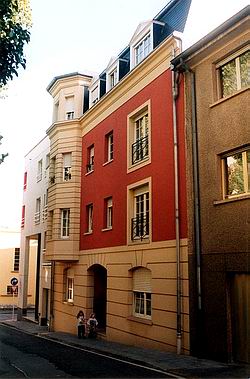
Townhouse Le Parisien II, Esch/Alzette, Luxembourg
by Mulhern & Steil, Luxembourg
(Photo by Colum Mulhern)
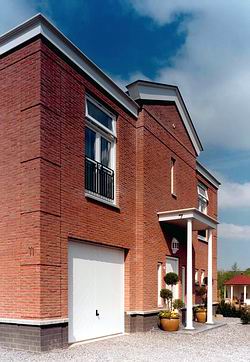
Jefferson House, Almeerderhout, Amsterdam
by Scala Architects, Mieke Bosse & Peter Drijver, Den Haag
(Photos by Scala)
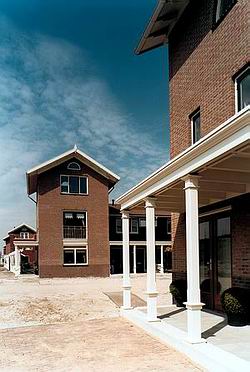
Nieuw Terbregge, Rotterdam
by Scala Architecten, Mieke Bosse & Peter Drijver, Den Haag
(Photo by Scala)
|
 |
|
|
 |
|
|
 |
|
|
|
 |
|
|
|
Style and Excellence
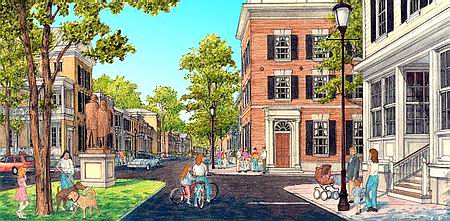
Rail Road Avenue, North Augusta, South Carolina
Savannah Riverfront Development
by Dover Kohl, Architects and Planners
"Style is not an art-historical fossil, nor
a restrictive positivist concept of a modernist academia...It has been disqualified by the Modern Movement at the beginning
of the XXth century; however the same ferocious 'Style' enemies found nothing better than 'International Style' to promote
their 'styleless' works!
Style remains an unavoidable concept to define and evaluate any serious work of art. The obsession to reformulate
its conceptual complexity into less controversial concepts and its elimination alltogether might just reduce our
theoretical paraphernilia in the context of discussing, designing and describing architectural artifacts!
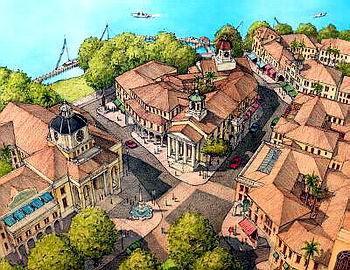
Aerial View of New Waterfront Quarter, Jupiter, Florida
by Chael & Cooper Architects & Dover Kohl, Architects and Planners
& Gentile-O'Mahoney Landscape Architects
We might consider to qualify style
as, - the support of coherence, consistence, syntax and formal elegance, - of sensitive tectonic discourse, - of compositional
and proportional excellence, - of correct reflection of typological and morphological conditions and urban or landscape context,
- of appropriate articulation of iconographical and artistical elements, - of just expression of character of program and
hierarchy, - of refined expression of a sense of place, etc. within an architectural language...
If we also acknowledged architecture as an integral part of a popular, understandable and communicable
artistical and urban culture - based on its historical traditions of tectonics, of representation and symbolism
- , it might be possible to overcome the confusion associated to the concept of style, often misunderstood as a revivalism
of historical styles, or as a replicative repetition of historic precedents.
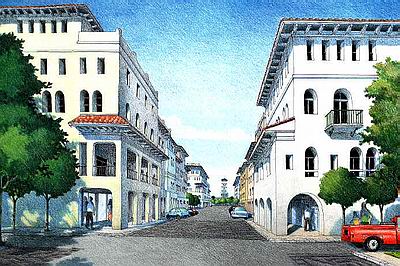
Industrial Design District, Coral Gables, Miami
View Along Bird Road
by Correa&Valle&Valle, Architects and Urbanists
|
|
